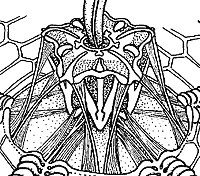
Aristotle's Lantern
Aristotle was a Greek teacher who lived more than two thousand years ago. To be exact, he lived from 384 to 322 B.C.E. (before the common era). Do those dates look backward to you? You need to remember that before Christ, dates count down to his birth and afterwards they count up. So if you do the math, 384 years plus our current date, you will find that if Aristotle was still alive he would be more than 2,398 years old!
Aristotle is best known for his work in philosophy. However, he also studied, experimented, and wrote many textbooks about the natural sciences. One of these books was called Historia Animalium or The History of Animals. Aristotle described the mouth parts of a sea urchin in this book. Below is the translated text.
"In reality the mouth-apparatus of the urchin is continuous from one end to the other, but to outward appearance it is not so, but looks like a horn lantern with the panes of horn left out."

As other scientists later studied and wrote about the urchin, the term Aristotle's lantern was used. This holds true thousands of years later.
Why a horn lantern? As it turns out, these lanterns were not shaped like a horn. Instead, they used thin pieces of horn on each of the lantern's sides. The pieces, also called panes, were thin enough to allow the light from the lantern to shine through, but protected the candle from being blown out by such things as wind. Horn lanterns have been made for many centuries and in many shapes. During Aristotle's life, horn lanterns had five sides. This made for a good comparison when writing about the sea urchin.
References:
Historia Animalium (The History of Animals, Book IV), by Aristotle, translated by D'Arcy Wentworth Thompson, classics.mit.edu/Aristotle/history_anim.4.iv.html
"Ethics: Western ethics from Socrates to the 20th century: THE CLASSICAL PERIOD OF GREEK ETHICS: Aristotle." Britannica Online.
Aristotle's Lantern illustration, by Livingstone, from the University of Ottawa, BIDIDAC web image database. Used with permission. biodidac.bio.uottawa.ca/
Sea urchin mouth image by Wilson44691 via Wikimedia Commons.
Read more about: Sea Urchins Do Research
Bibliographic details:
- Article: Aristotle's Lantern
- Author(s): Dr. Biology
- Publisher: Arizona State University School of Life Sciences Ask A Biologist
- Site name: ASU - Ask A Biologist
- Date published: 17 Dec, 2009
- Date accessed:
- Link: https://askabiologist.asu.edu/aristotles-lantern
APA Style
Dr. Biology. (Thu, 12/17/2009 - 12:23). Aristotle's Lantern. ASU - Ask A Biologist. Retrieved from https://askabiologist.asu.edu/aristotles-lantern
Chicago Manual of Style
Dr. Biology. "Aristotle's Lantern". ASU - Ask A Biologist. 17 Dec 2009. https://askabiologist.asu.edu/aristotles-lantern
Dr. Biology. "Aristotle's Lantern". ASU - Ask A Biologist. 17 Dec 2009. ASU - Ask A Biologist, Web. https://askabiologist.asu.edu/aristotles-lantern
MLA 2017 Style

View of the mouth of a sea urchin (Strongylocentrotus purpuratus) showing the teeth of the Aristotle's lantern.
Be Part of
Ask A Biologist
By volunteering, or simply sending us feedback on the site. Scientists, teachers, writers, illustrators, and translators are all important to the program. If you are interested in helping with the website we have a Volunteers page to get the process started.

